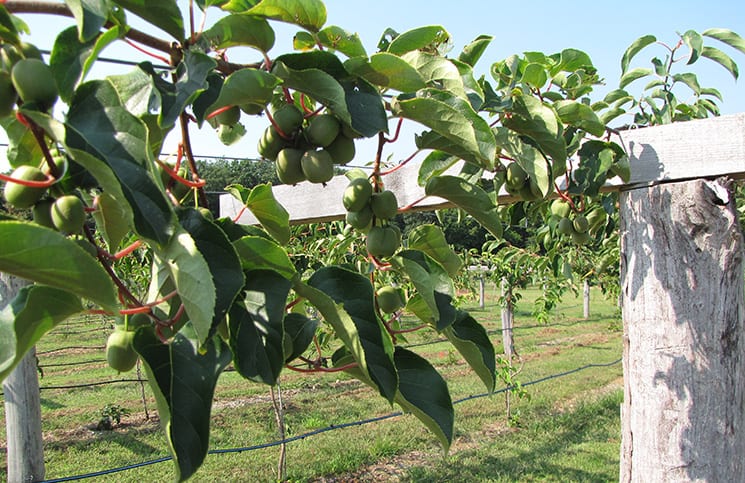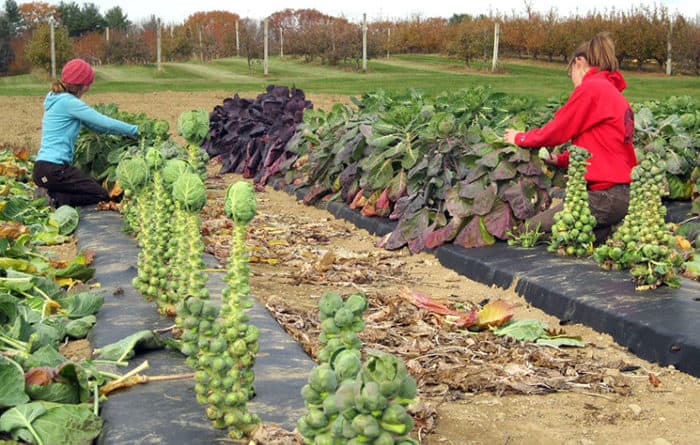Becky Sideman, a researcher with the N.H. Agricultural Experiment Station (NHAES) at the University of New Hampshire, loves Brussels sprouts. But the real reason she started researching the best varieties of the vegetable to grow in New England three years ago is simply because no one else had done it.
“There were no variety trial results. Nobody in New England had done this work, and we see a lot of regional variation and varietal performance,” says Sideman, who is also a professor of sustainable horticulture production. “It seemed like, since this work had not been done, (it had the) potential to have a big impact on growers’ crops.”
Sideman and other researchers will present their latest findings on everything from Brussels sprouts to growing cold-hardy kiwis in the Granite State at the upcoming New England Vegetable and Fruit Conference, taking place in Manchester Dec. 15-17.
Lori Wright, the communications coordinator for NHAES, said many of the station’s projects evaluate fruits and vegetables in terms of taste, marketable yield, and disease resistance — in other words, the sort of qualities New Hampshire’s 4,400 farmers are looking at when it comes to growing and selling their crops.
 NHAES researchers think cold-hardy kiwis might be a profitable crop for N.H. farmers.
NHAES researchers think cold-hardy kiwis might be a profitable crop for N.H. farmers.
“The results … are shared with farmers, producers, and growers across the state and region so that they can use them as part of their business decision-making process,” Wright says.
That means that, thanks to Sideman’s research, you might start seeing more Brussels sprouts at your local farmers market. According to Sideman, most of the Brussels sprouts you see at area supermarkets are grown in California, the largest production region for the vegetable. Brussels sprouts are grown in New England, but Sideman says they’re mostly grown in small quantities.
Sideman’s research focused on two areas: which varieties of Brussels sprouts grow best in New England, and whether topping — pinching off the top of the plant — can improve the growth of the sprouts. Sideman ran growth trials for three years. The first question turned out to be the easiest to answer. Three varieties — Nautic, Diablo, and Jade Cross E — had the best yields. The efficacy of topping, though, was a little more difficult to answer. Some varieties responded well to topping, while others didn’t.
“We’ve figured out that the varieties are really different from one another. They vary in lots of ways,” Sideman says. “At this point, we have pretty solid recommendations about consistently high-performing varieties … and we can do a pretty good job on explaining topping and when it’s helpful and not helpful.”
Because every growing season is different and presents different variables, such as changes in weather and precipitation levels, it takes at least two years to do this type of research.
“We typically like to do all things at least twice, but it’s better to do it three times, to try and narrow down what’s consistently going to happen,” Sideman says.
At the conference, NHAES researcher Brent Loy, who has been researching squash, melon, pumpkins, and gourds for five decades, will present his latest findings on the effect of grafting melons onto the rootstocks of hybrid squash. Plant breeder and researcher Iago Hale will discuss his work on bringing cold-hardy kiwis, which he’s been growing since 2012. Cold-hardy kiwis are about the size of a grape and have an edible, thinner skin, unlike their fuzzy cousins. They could potentially be a high-value crop for New England farmers, Hale says.
According to Wright, the results from the experiment station’s research goes from local farms to local dinner tables and beyond. Recent projects include new methods for detecting bacterium that contaminate oyster beds in the region (and can sicken consumers) and ways for foresters and landowners to assess forest inventories using new technologies.
For Sideman, the three years she spent growing various varieties of Brussels sprouts will ultimately give local farmers a leg up. And, she adds, it can help backyard gardeners, too.
“It’s expensive for (farmers); they invest a lot when they grow a crop, and for them to do the kinds of experiments we’re doing … would be expensive and time-consuming and they might not end up with good, marketable yields in the end,” she says. “We know many (farmers) use this information, which is gratifying, and why we do it.”

